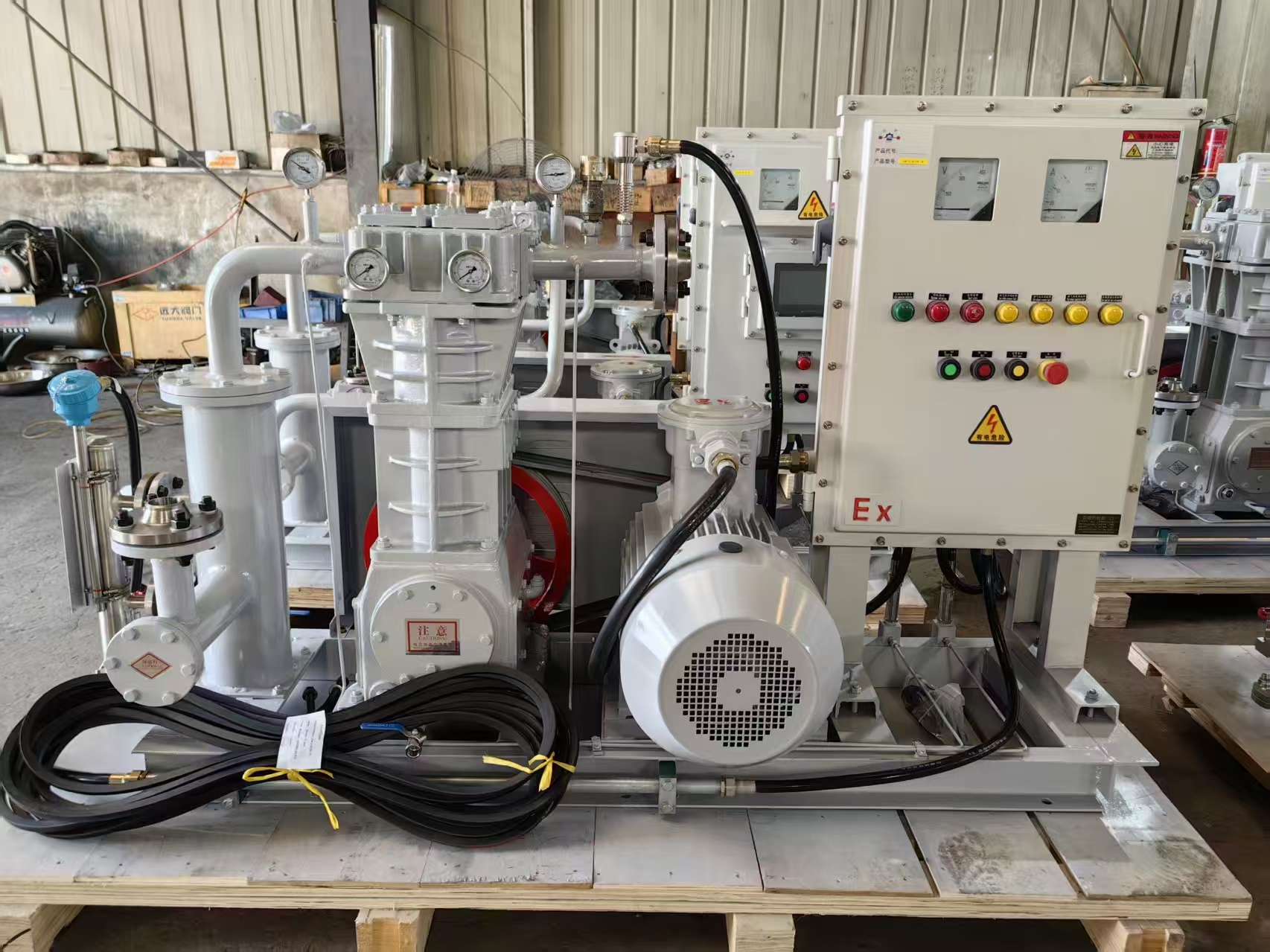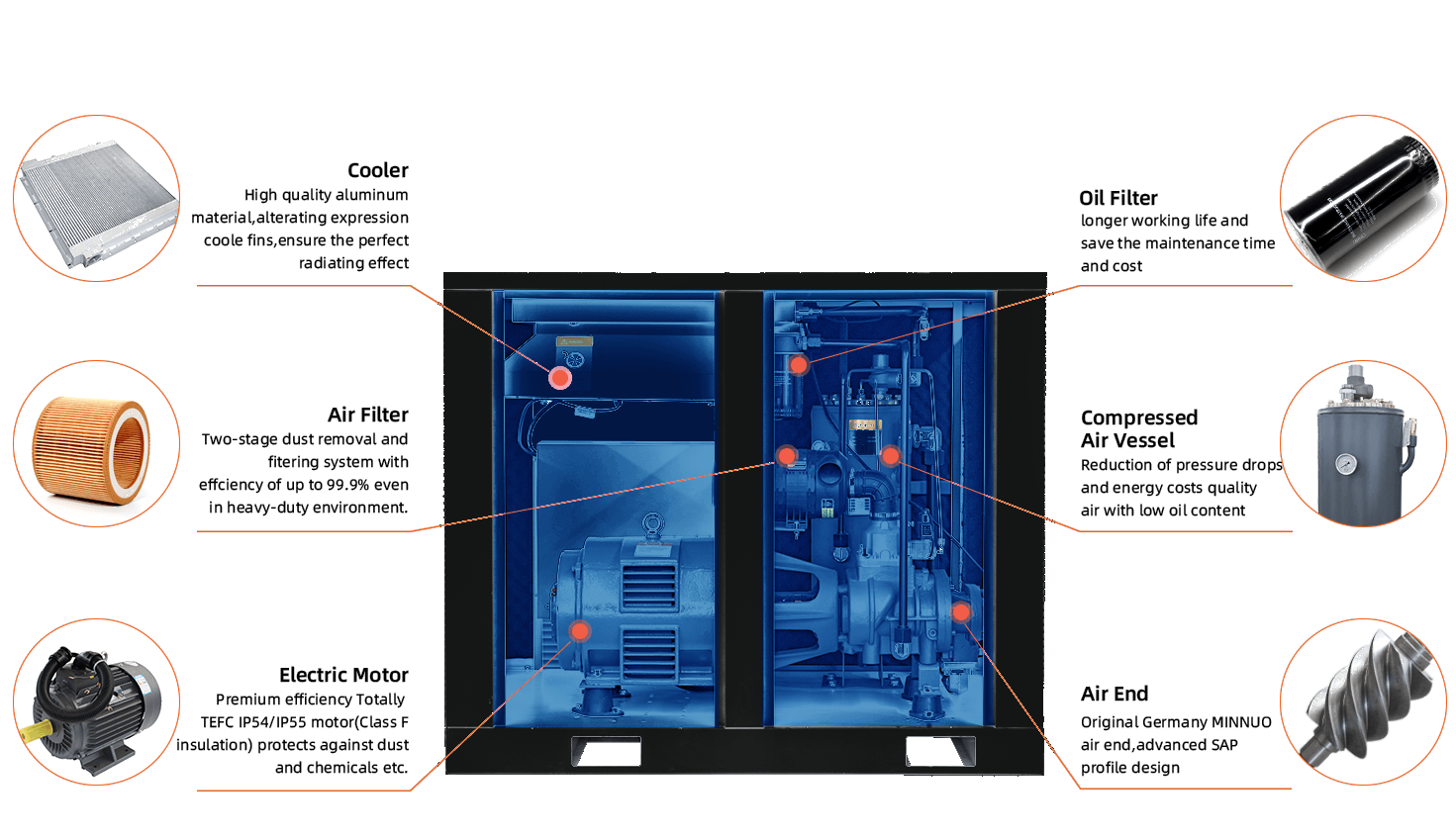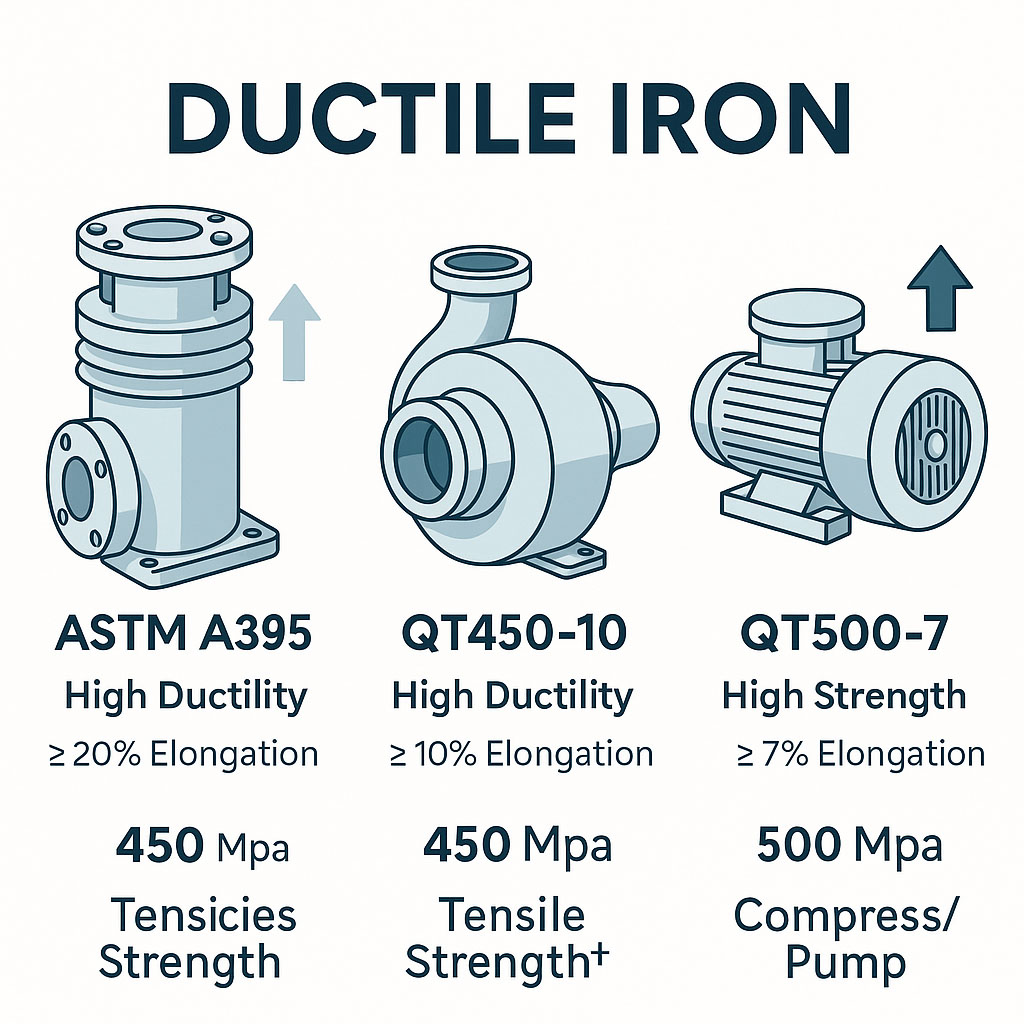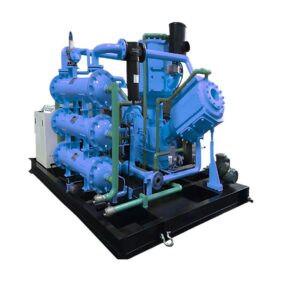Wie funktioniert ein Hubkolbenkompressor?
Hubkolbenkompressoren Umwandlung von Rotationsenergie in Hochdruckgas indem ein Kolben in einem Zylinder hin und her bewegt wird. Denn jeder Hub schiebt - oder erwidert-Gas liefern diese Maschinen präzise Volumina bei hohem Druck, was ihre Beliebtheit in petrochemischen, Wasserstoff- und Stickstofferhöhungsanlagen erklärt.
1. Kernkomponenten und Flussweg
-
Kurbelwelle & Motor
Die Kurbelwelle, die direkt von einem Elektromotor angetrieben wird, dreht sich kontinuierlich; sie wandelt also die Drehbewegung in eine lineare Kolbenbewegung um. -
Pleuelstange und Kolben
Wenn die Stange schwingt, bewegt sich der Kolben auf und ab und vergrößert und verkleinert so abwechselnd das Zylindervolumen. -
Ansaug- und Auslassventile
Wenn sich der Kolben absenkt, öffnen sich automatisch die Ansaugventile und saugen Prozessgas in die Kammer. Umgekehrt öffnen sich beim Aufwärtshub die Auslassventile und drücken das komprimierte Gas heraus. -
Kühlung und Schmierung
Eine wirksame Schmierung verringert die Reibung; Zwischen- und Nachkühler senken die Ausblastemperaturen und schützen so die nachgeschalteten Geräte. Das KEEPWIN-Wassermanteldesign führt bis zu 90 % Wärme vor der nächsten Stufe ab und verlängert so die Lebensdauer der Ventile.
2. Einstufiger vs. mehrstufiger Betrieb
Einstufige Modelle eignen sich für niedrige bis mittlere Drücke (< 1 MPa). Wenn der Prozess jedoch höhere Drücke erfordert - z. B. 25 MPa für Wasserstoff-Röhrenanhänger - werden mehrstufige industrielle Kolbenkompressoren erforderlich. Das Gas durchläuft mehrere Zylinder nacheinander; nach jeder Stufe führen Zwischenkühler die Wärme ab und erhöhen so die Effizienz und Sicherheit.
3. Hubkolbenkompressor vs. Schraubenkompressor
| Artikel | Hubkolbenkompressor | Schraubenkompressor |
|---|---|---|
| Druckbereich | Bis zu 100 MPa (sehr hoch) | Typischerweise < 3 MPa |
| Durchflusskontrolle | Feststehend, präzise | Breit, stufenlos |
| Wartung | Ventil- und Kolbenverschleiß; dennoch sind die Teile leicht austauschbar | Rotorspaltverschleiß; für die Überholung sind Spezialwerkzeuge erforderlich |
| Energie bei Teillast | Besser (Ventilentlader) | Gut (VSD-Motoren) |
Weil Hubkolbengeräte sich bei hoher Druck / niedriger Durchfluss Aufgaben, petrochemische und CNG-Stationen entscheiden sich häufig für sie. In der Zwischenzeit dominieren Schneckenmaschinen bei kontinuierlichen, großvolumigen Anwendungen wie z. B. bei der Versorgung von Schüttgut.
4. KEEPWIN Real-World Case
Für ein saudi-arabisches Wasserstoffbetankungsprojekt wurde der Reinheitsgrad 99% bei 30 MPa benötigt. KEEPWIN lieferte eine vierstufige Gas-Kolbenkompressor mit leckdichten PTFE-Kolbenringen. Infolgedessen blieb die Reinheit nach 9 000 Stunden bei > 99 %; die Ausfallzeit sank um 18 % gegenüber der älteren Schraubeneinheit des Kunden.
5. Checkliste für die vorbeugende Wartung
Regelmäßige Pflege verdoppelt die Lebensdauer. Befolgen Sie diese Schritte jedes Quartal:
-
Ventile auf Kohlenstoffablagerungen untersuchen; auswechseln, wenn Leckrate > 3 %.
-
Kolbenstangenschlag prüfen; unter 0,02 mm halten.
-
Ziehen Sie die Bolzen des großen Endes nach 6 000 Betriebsstunden nach Vorschrift an.
-
Kurbelgehäuseöl wechseln; zusätzlich den Säuregehalt des Schmiermittels prüfen.
-
Prüfen Sie die Protokolldaten und passen Sie die Sollwerte für den Entlader an, um die Leerlaufzeiten zu reduzieren.
6. Kurzanleitung zur Fehlersuche
| Symptom | Wahrscheinliche Ursache | Sofortige Maßnahmen |
|---|---|---|
| Hohe Entladetemperatur. | Kühlerverschmutzung | Lamellen reinigen; Wasserdurchfluss überprüfen |
| Übermäßige Vibration | Lose Fundamentbolzen | Nachziehen; Ausrichtung prüfen |
| Geringe Kapazität | Undichte Ventile oder verschlissene Ringe | Dichtheitsprüfung durchführen; ersetzen |
7. Die wichtigsten Vorteile auf einen Blick
-
Hohes Verdichtungsverhältnis pro Bühne, was Platz spart.
-
Flexibilität-modulare Zylinder ermöglichen zukünftige Kapazitätserweiterungen.
-
Leichtigkeit der IsolierungDaher kann ein einzelner Zylinder gewartet werden, während andere laufen (bei Multiblock-Konstruktionen).
8. Schlussfolgerung
Wenn Ihr Prozess erfordert hoher Druck, Reinheit und präziser Durchsatzan industrieller Hubkolbenkompressor ist nach wie vor die zuverlässigste Option. Sorgfältige Paarung Wartung von Hubkolbenkompressoren mit der robusten Technik von KEEPWIN hält Ihre Anlage produktiv, sicher und profitabel.
Sind Sie bereit, die richtige Größe für Ihr Gerät zu finden?
Wenden Sie sich noch heute an die KEEPWIN-Ingenieure, um eine maßgeschneiderte Berechnung und ein Angebot zu erhalten.











